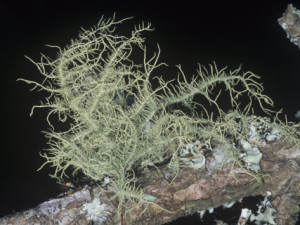
Usnea stringosa, photo by William Weber
Chef and forager Dan Dowling sent me an excellent picture of lichen (above.) The reason why he took it is the photo shows two common lichen people get confused, Ramalina near the center, and Usnea on our upper right (above some rag lichen.) Almost all lichen are edible once leached of their bitter acids. The flavor ranges from bad to almost palatable. But, they are high in calories, have saved many a stranded hunter or downed pilot, and are found nearly worldwide. Lichens have been used in dyes, deodorants, laxatives, expectorants, tonics, and as one monograph put it, “healing pastes.” They are also an indicator of clean air. We’re more interested in Usnea than Ramalina for its medicinal qualities. Usnea is basically an antiseptic. While Ramalina and Usnea resemble each other there are three main differences: The Ramalina’s stems are flatish, Usnea is round; Ramalina does not appear to be hairy, Usnea looks hairy; and only Usnea — among all the many genus of lichen, has an elastic, white inner core. If you want to read more about lichen (Yes, the rag lichen is edible but it tastes like dirty tree bark.)
This week saw me in and about Gainesville and attending the Florida Earthskills gathering. I’d like to thank Mycol Stevens for having me back for a second year to teach foraging classes. Having learned last year that the weeds there can vary with the amount of rain I collected seasonal edibles from local areas as well as on site. Next year I will have to remember to take camphor seedlings with me. I was going to camp out in my newly resurrected van but unusually cold nights and a visiting a friend recovering from major surgery prevented that. Three wild edibles stood out from the many ones we find this time of year. First were Silverthorn berries.
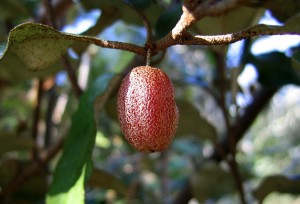
The jelly-bean size Silverthorn berry. Photo by Floridata
Related to the Russian and Autumn olives the Silverthorn is an escaped ornamental. Thus eating as many ripe berries as one can is a civic duty to reduce its naturalization. The shrub escapes from hedge rows. The largest and longest planting of Silverthorn I have ever seen in just north of Ocala, Florida, while on the way to Gainesville. There is well over a half-a-mile of unattended hedge about eight feet high and eight feet wide heavily ladened with sweet fruit. (For you local residents it is on the north side of 326 one half mile east of where 326 intersections with 301/441.) Silverthorn is atypical in that it fruits in January and February, depending where you are. And it can be found farther north than just Florida. If I remember correctly no plant produces more lycopene than the Silverthorn and the seeds are high in omega 3 fatty acids. To read more about the Silverthorn go here.
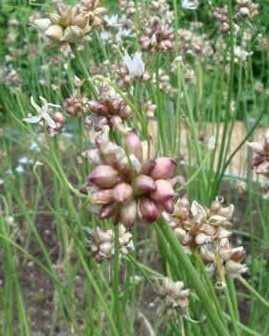
Wild Garlic, photo Prairiemoon
The second find was during a class in Gainesville. Wild Garlic is difficult to find in Central Florida. I’ve been wanting to do a video about it for several years but the old haunts where I used to collect it are now parking lots or housing developments. I knew it grew in Gainesville because I saw it once at a private class I taught there a few years ago. But, it’s never been apparent in my other classes there until this week. Because of my first cold in seven years my nose wasn’t working well but one of the students ask where the garlic aroma was coming from: Wild garlic under our feet was the answer. It was not yet putting on cloves so it was not easy to see visually. But it is always a delightful find; pungent, sharp, tasty. You just know it was a welcomed winter green and flavored many an ancient meal. Wild garlic, wrongly called wild onion, is unusual in that it puts cloves on the top of its stem, not underground on the bottom. (Onions put on a bulb, garlic puts on cloves.) To read more about the wild garlic, click here. Where we found it in Gainesville was in the ditch across the street and slightly northeast from the four parking spots on Palm Point Park on Lakeshore Drive off SE Hawthorne road. (Take it home and transplant it to a more wholesome environment.)
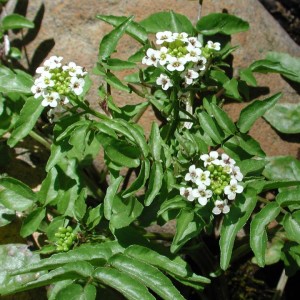
Watercress, photo by Max Licher
The other mentionable was found by curiosity. Just before reaching the Florida Earthskills site I wondered if a mound of green in a ditch was young deadly Water Hemlock. A closer look proved it to be Watercress, an esteemed edible (if in wholesome water.) Central Florida is the Watercress capital of North America and has escaped from cultivation. From the back of a motorcycle going 65 Water Hemlock and Watercress bear some resemblance. Up close they do not. However, they do grow in the same environment and can do so at the same time of year, intermixing. Thus one harvests Watercress carefully checking twice just to make sure no stray Water hemlock leaves gets in the mix. Usually when folks die from eating wild food if it isn’t a mushroom it’s Water Hemlock. When I say they don’t look alike that depends on how closely one looks, or can look. They have qualities in common but so do people. Even twins have some differences if you look close enough. Watercress is very seasonal and should be harvested when you find it if you find it in wholesome areas. To read about Watercress go here. To read about the deadly Water Hemlock go here.
Thistle Epistle: Sorting out true thistles for food is on par with identifying true pines and oaks. If it is a Quercus the acorns are edible (after necessary leaching.) The particular species is usually not relevant. If it is a Pinus it has parts you can eat. Again the particular species is usually not relevant. And all Cirsiums — true thistles — are edible though the flavor and texture will vary from species to species. Thus telling true thistles from each other is matter of form than necessity but here is how to tell a couple of common ones apart:
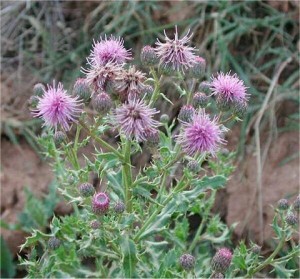
Canada Thistle, photo by the Univ. of Iran
Cirsium arvense: The Canadian thistle grows from one to five feet tall. Its main stems is ridged, slightly spiny, and branches near the top. The leaves are lance-shaped, spiny and deeply cut whereas the flower heads are smooth and occur in small clusters. The upright flowers are NOT spiny and can be white, purple or light lavender. Its one-eighth inch seeds are smooth, brown and pointed. This member of the sunflower family has fleshy, creeping roots.
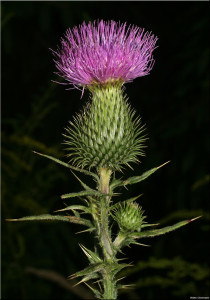
Bull thistle, photo by Walter Obermayer
Cirsium vulgare, the Bull Thistle, looks similar to the Canadian Thistle. They grow to similar heights and have prickly stems. The Bull thistle also has white to purple to pale lavender upright blossoms but they are spiny and solitary, NOT in clusters. In both species the blossom resembles a shaving brush. Bull thistle leaves are larger and more spiny than the Canadian Thistle and have prickly hairs on the upper surface.
A third similar thistle, Cirsium edule, the so called “Edible Thistle” has a drooping flower head and only grows from Oregon and Idaho north in western North America. To read more about true thistles go here.
Frostbites: Our last average frost date in central Florida is Valentine’s Day, if we have a frost or freeze at all. Some winters we don’t dip into freezing. But, there is a full moon on the 25th of February. That usually brings cold weather — said the gardener — as will the full moon on March 27th. There is a full moon on April 25th, too, but a frost in April is rare though the latest one on record locally is April 24th. I mention frost and cold weather because my mulberry is putting on fruit and a frost could ruin the crop. There is also the odd fact that I get frost in my front yard more often than my back yard, which is geographically the opposite of what one would expect. Mother Nature plays by her own rules.
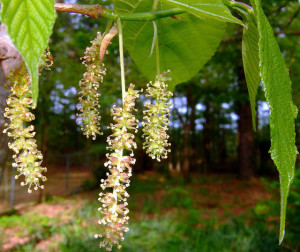
Mulberry in Blossom, photo by James Baker
I don’t think plants can think but their behavior can echo historical experience. In that regard my mulberry tree — a native — is far more experienced than my peach or nectarine, man-crafted hybrids. At the slightest hint of warm weather the peach and nectarine will blissfully blossom only to get slapped with a cold snap. This has happened for several years in a row. Blossoms fall like freezing rain. The mulberry is more restrained. It doesn’t get all blossomy unless it thinks warm weather is really here. So my mulberry is putting on fruit, but we have at least two more full moons to go. We’ll see what happens.
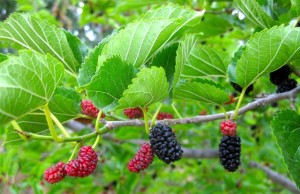
Ripening Mulberries, photo by Missouri Permaculture
Almost all of the mulberries locally are red mulberries, native and cultivated. They usually take a rest a month or two around Christmas. Early January is a good time to trim them. With February just here new leaves and blossoms are appearing. What you may not know is that young mulberry leaves are edible cooked. Quite mild. The green fruit is also slightly mind-altering. To read more about the mulberries go here.
Don’t forget the The Florida Herbal Conference less than two weeks away, still plenty of time to sign up. This year it is held in Deleon Springs February 15-17. For more information go to: Florida Herbal Conference.
Upcoming classes: My schedule appears light this month because I’m teaching at two conferences.
Saturday, February 9th, Highwoods Preserve, 8401 New Tampa Blvd., Tampa FL, 33647., 9 a.m.
Sunday, February 10th, Mead Garden, 1500 S. Denning Dr., Winter Park, FL 32789. 9 a.m.
Saturday, Feb. 16th, Lake Woodruff National Wildlife Refuge, 2045 Mud Lake Road, DeLeon Springs, FL . 32706, 10 a.m.
Sunday, February 24th, Florida State College, south campus, 11901 Beach Blvd., Jacksonville, 32246. 9 a.m.
Note the starting times vary. For more information on my February classes go to my main website and click on classes.
To donate to the Green Deane Newsletter click here.

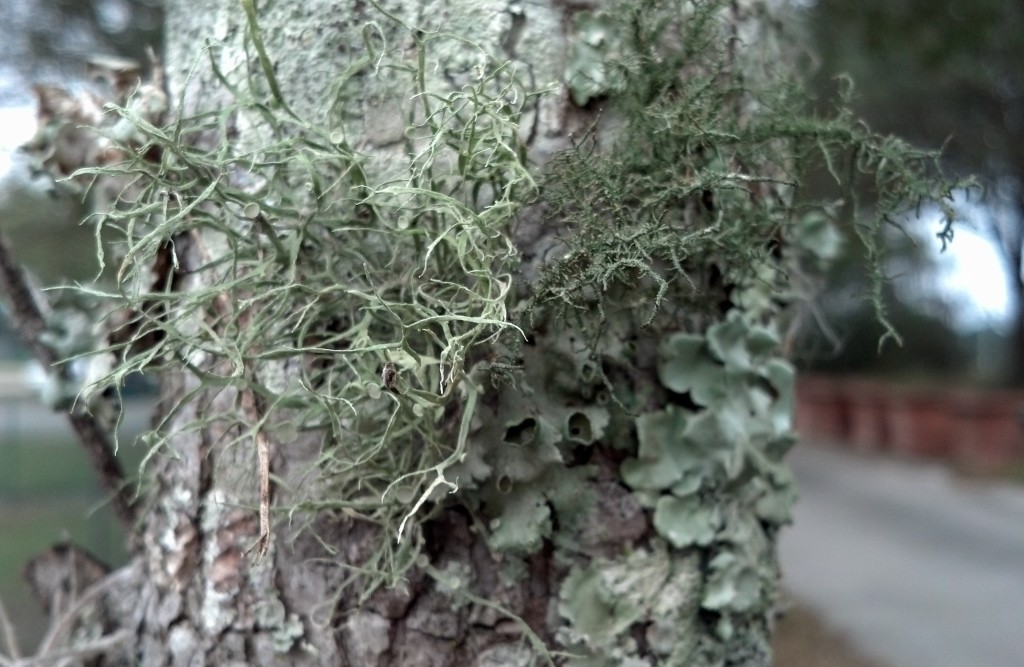
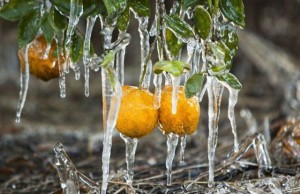

Silverthorn has to be the most underrated edible that is easily found through the state. I actually planted some on my property, they are truly “edible” as in good tasting. Thanks for another great newletter.
True… I found it interesting that Floridata says they are worthless…
They grow prolifically here in Georgia and yes, they are delicious!
I wonder Deane if your observation on the variation on the frost on your front and back gardens is applicable to nearby gardens as well, and if that bears any scientific significance. On the other hand, I like your suggestion that plants’ behaviour can echoe historical experience as exemplified by your mulberry peach or nectarine, man-crafted hybrids and their blossoming behaviour. If I may add, it has all to do with existence and love of life an instinct mother nature has granted all of us , we living ” creatures ” including plants.